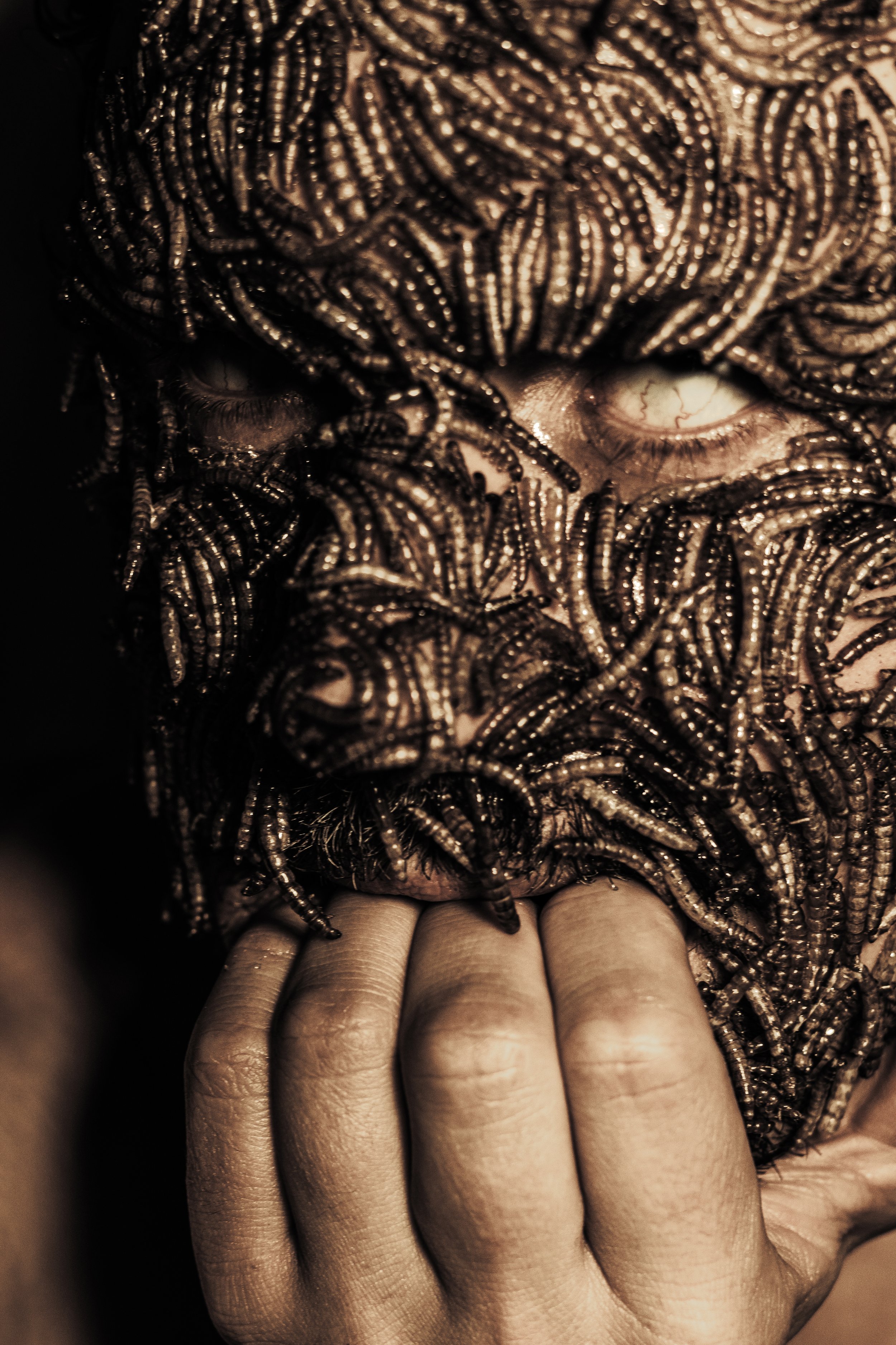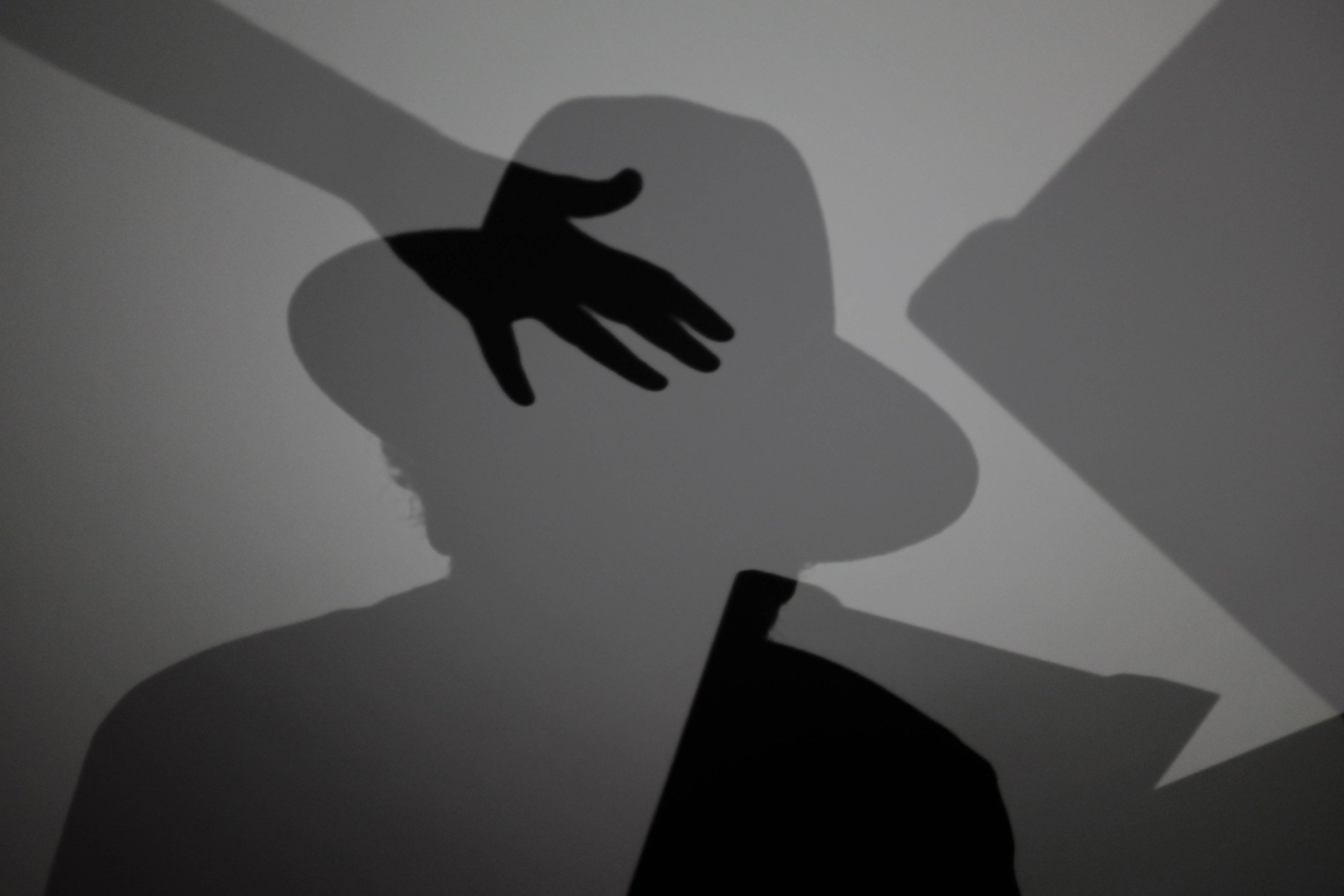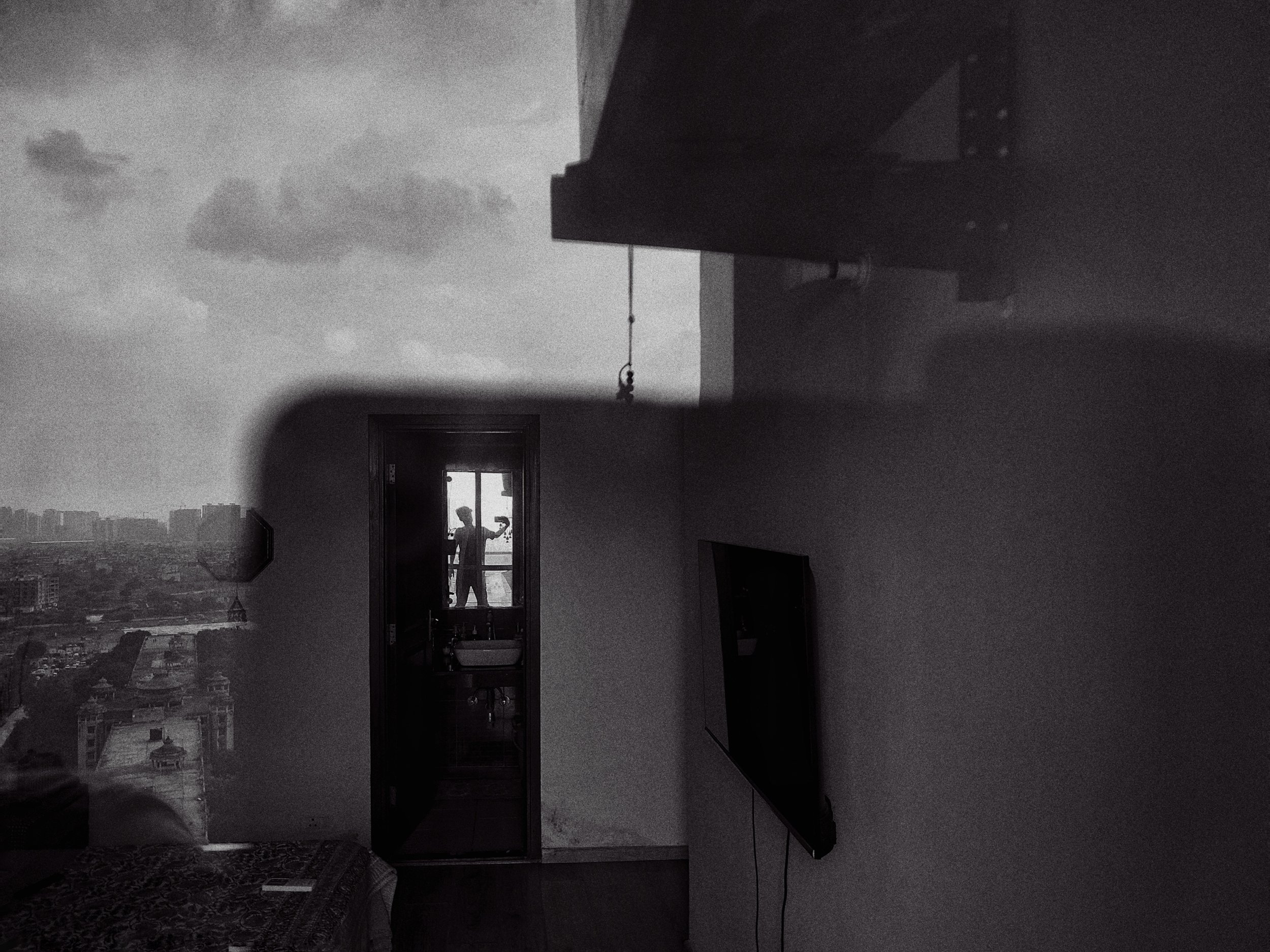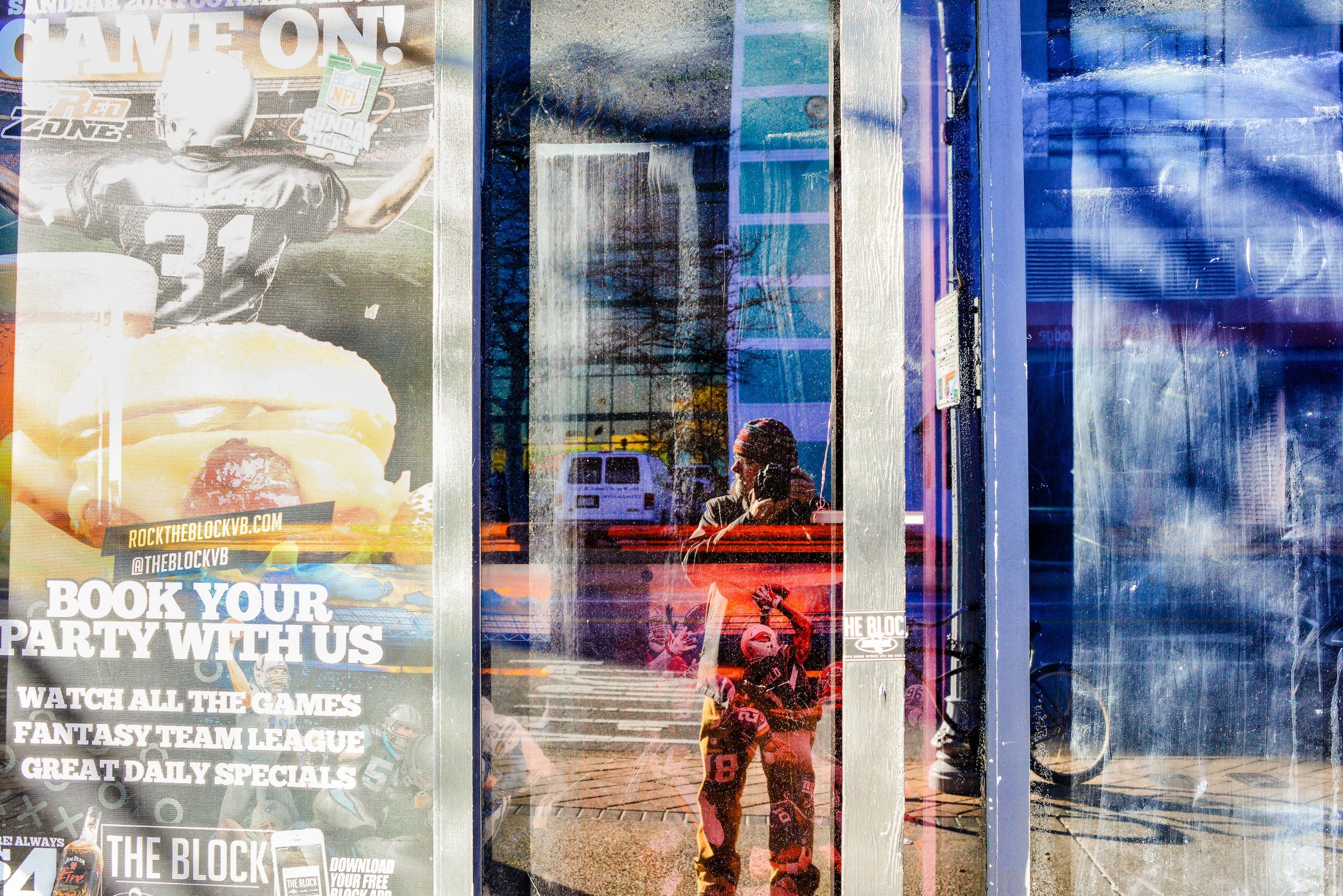THE WINNER
Self-portraits: for the artistic projects section.
Capturing a series of good self-portraits is challenging; however, once achieved, it reveals something significant about the photographer.
When entries for the competition were accepted, we aimed to avoid emphasizing any details that could reveal the motivations and nationality of the participants.
The judges approached the submissions with an unbiased perspective. It wasn't until we were preparing this book that we discovered the majority of the participants are Ukrainian – Iryna Kabysh, Savka, Andrii Bulavka, Iryna Vlasiuk, Li Biletska, Polina Shumacher, Anton Konovalenko –, and that many of the projects are influenced by the ongoing war in the region.
The winning project, made by an expatriate Russian, is especially representative of this.
Polina Schneider First Place "I, Superhero"
The use of the masks is one of those tropes that could have easily fallen into boring cliché; however here they take on real character, depth, and expression far beyond the frozen face of the mask itself. By placing the character in different scenes, each reflecting a different mood and situation, they have created a strong dynamic tension within the series. ( Richard Bram) – It is a series with originality and diverse themes. The expression on the mask used by the author conveys a sense of boldness to the observer. (Ana Abrão) – Cat masquerade; witchcraft, magick, mysticism, nine lives, fearless. There is much to like. (Kevin Lim)
Polina Schneider Born in St. Petersburg during the Perestroika, Polina Schneider grew up exposed to different languages, cultures, and religious beliefs. In 1997, she migrated to Germany, encountering yet another cultural perspective.
"I, Superhero" is Paoline's response to the Russian invasion of Ukraine. The portrait series is intended for those with a Russian background who feel overwhelmed by political propaganda. To oppose Putinism, she has created "Grumpy Superhero," a feminist protagonist aimed at making sense of the situation. The character offers a subtle look at the emotional landscape of the conflict. Today's Russia is depicted as a dystopian fantasy created by one narrow-minded person, but the superheroines inside of us offer hope.
SECOND PLACES:
Iryna Kabysh, Savka, Andrii Bulavka
Iryna Kabysh is an artist from Kyiv, Ukraine, interested in combining art and logic. She is fascinated by the different qualities of light and its effects. Despite her background in painting, interior design, and modelling, Iryna only started using a camera during the COVID-19 quarantine. After graduating from Kyiv Photography School and MYPH (Mykolayiv Young Photography School), she began working on personal art projects. Her project "Fruitfulness" was highly praised by the judges.
Iryna Kabysh - Love this one; pregnancy with flora, fauna, and mineral. Fertility in all forms signifies new beginnings and the power of women. (Kevin Lim) - The photographer here has made a strong series of photographs using different objects as metaphors for her womb and it many rôles both physical, psychological, and societal. (Richard Bram)
Savka (Oleksandr Savchuk ), born in 1994 in Pokrov, Dnipro region, Ukraine, currently lives and works in Kyiv. He graduated from the Kyiv University of Culture in 2016, majoring in Design. The essence of "Pages", a project spanning from 2023 to 2024, lies in the idea that our life is like a book, and every stage (page), whether marked by success or failure, is equally precious. Through this series, Savka aims to motivate us to appreciate our personal experiences and the growth they bring. The project encourages introspection on our accomplishments and fosters gratitude for the obstacles we have surmounted. It underscores the significance of every chapter in our life story.
Savka - I’m a sucker for a really good interpretation of an art movement, in this case Russian Constructivism. It has echoes of the geometric obsessions of the 1920s and 30s in both early Soviet Russia as well as Weimar Germany. They are beautiful constructs, with the body both breaking through and becoming separate parts of the whole structure. (Richard Bram)
- A very creative work. The author shows a great ability to use the space. Unusual use of body language and graphic elements. It was a good choice by the author to maintain the square format and similar editing throughout the series. (Ana Abrão)
An excellent and imaginative set of pictures that have a distinct style and yet each picture stands on its own merits. In general I dislike ‘effects’ in photographs as often the special effect becomes the main focus of the picture. In this case the post processing adds an intriguing but complimentary aspect to the images. The photographs before the post work are already excellent and he has done well to come up with additions that serve to add an extra dimension. (John Gill)
This superbly executed series speaks to me of confinement and powerlessness. (Keef Charles)
Andrii Bulavka is from Dnipro, Ukraine and studied at Oles Honchar Dnipro National University. After his time at Le Mans University in France, he settled there. Currently, he manages website content at Chanel and has been focusing on photography since 2020. Inspired by French photographer Willi Ronis, he aims to establish his unique visual style and connect with the Ukrainian photography community before expanding to the French scene. His photo project "Les cauchemars" (inspired by Franz Kafka's "Metamorphosis") captures moments of solitude in his small Parisian apartment. Here, he finds himself alone with his camera. The absence of the external world and onlookers allows the photographer to feel renewed, liberated from societal facades. In the process of creating this work, he suddenly discovers that his body can be plastic, and the ordinariness of the things surrounding him becomes poetic, even dramatic. Each photograph bears witness to his experiment with his personality and emotions while confronting his inner demons. By enclosing himself within the confines of a small apartment, he confronts his inner demons in a unique way, allowing him to delve into his emotions
Andrii Bulavka: "Les cauchemars" - The author reveals creativity and boldness in his creations. One of his images demonstrates a high ability to think outside the box when creating self-portraits. (Ana Abrão)
THIRD PLACES
Alberto M. Melis, Petros Kotzabasis, Sylwia Ciszewska Peciak
Alberto M. Melis. Born in Cagliari, Italy, in 1957, Melis began his photography journey at a young age, experimenting with film processes. He collaborated with the University of Cagliari on research and exhibitions showcasing traditional architecture in Sardinia. Subsequently, he curated exhibitions focused on the Roma ethnic group, contributing to a book on the subject. Transitioning his focus to teaching, journalism, and writing for children, he authored over 40 books. Melis later returned to photography, primarily focusing on street photography. He has showcased two exhibitions dedicated to urban solitude and is currently immersed in ongoing projects. Putting together a small project of self-portraits first requires a robust supply of self-irony. Especially when the attempt is to relate to the relentless flow of time. An unstoppable flow from which we tear, with our photographic lenses, small fragments of memory. Fragments of Memory, however, that remain fully intelligible only to our gaze.
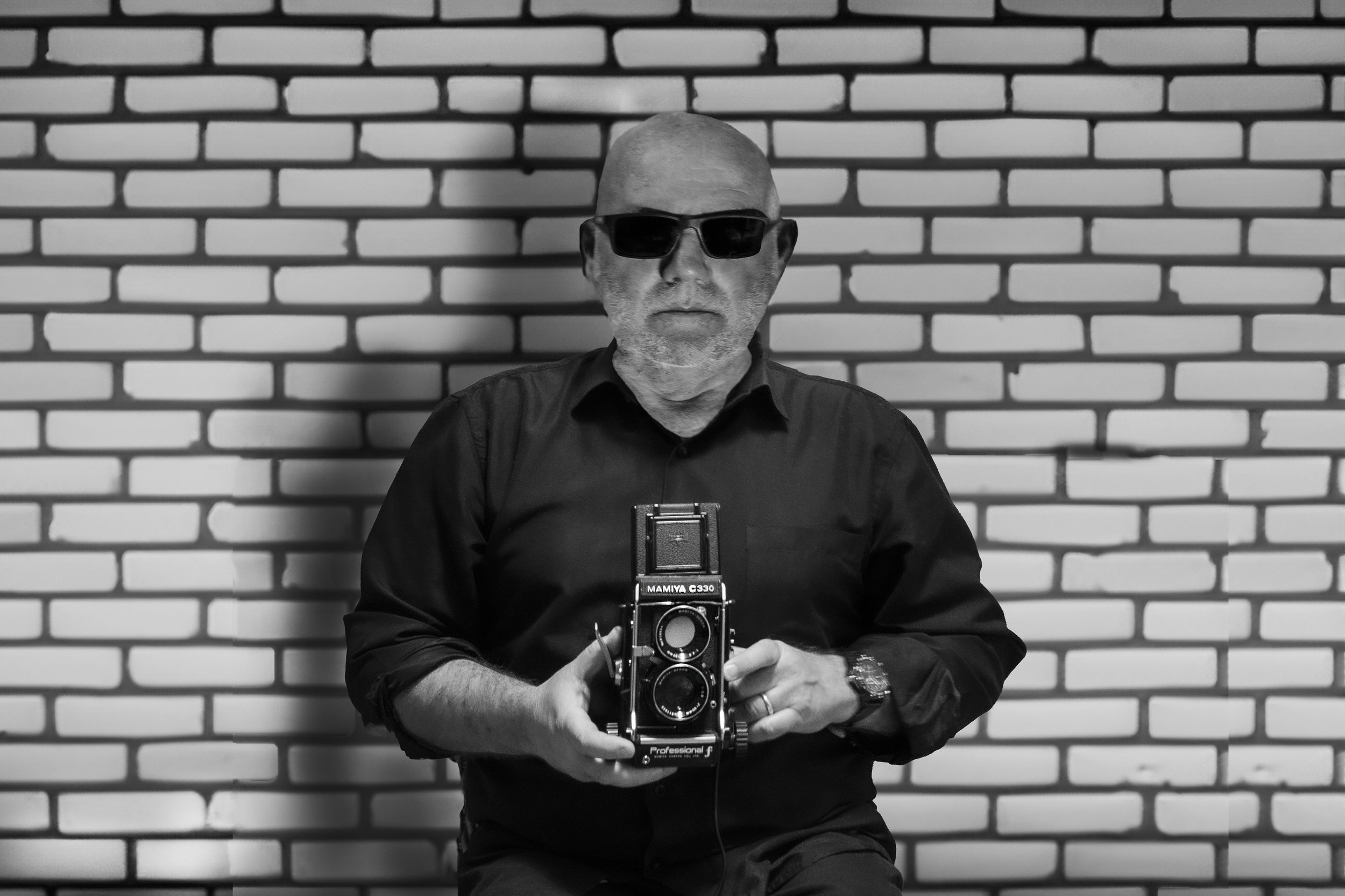
Alberto M. Melis - The author kept the framing simple and free of distractions throughout the series presented. Good choice in keeping the same color palette. (Ana Abrão)
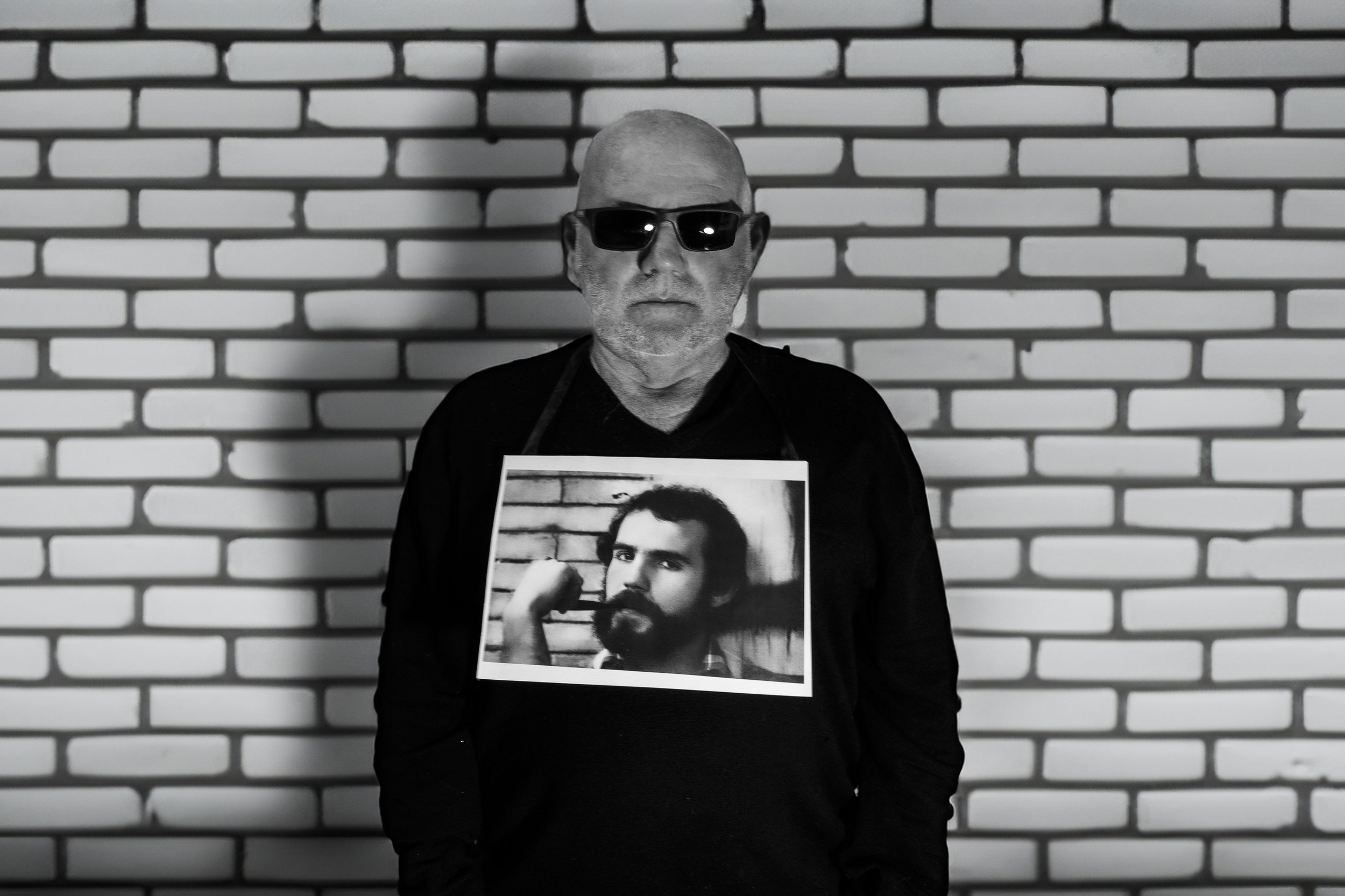
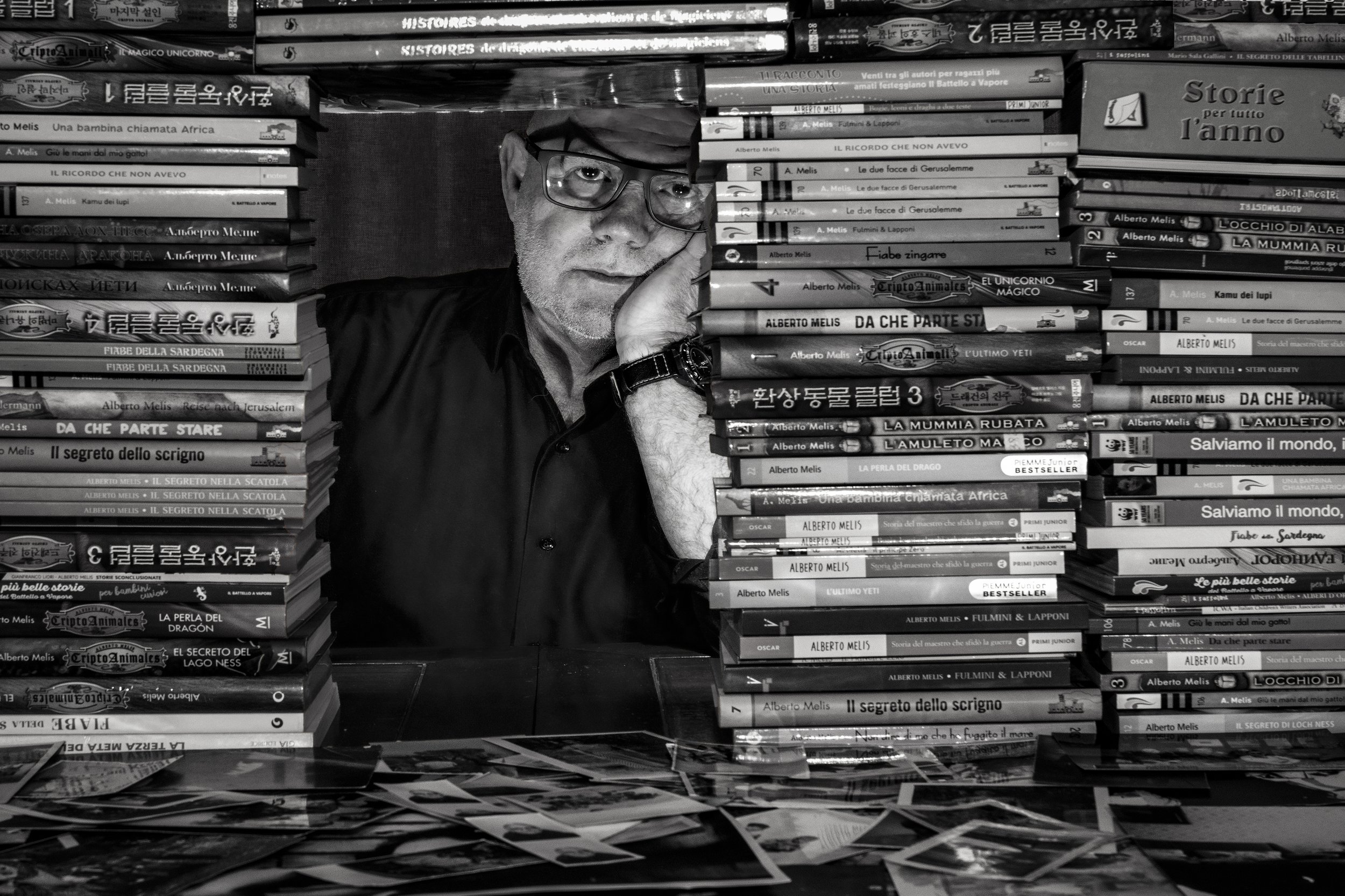
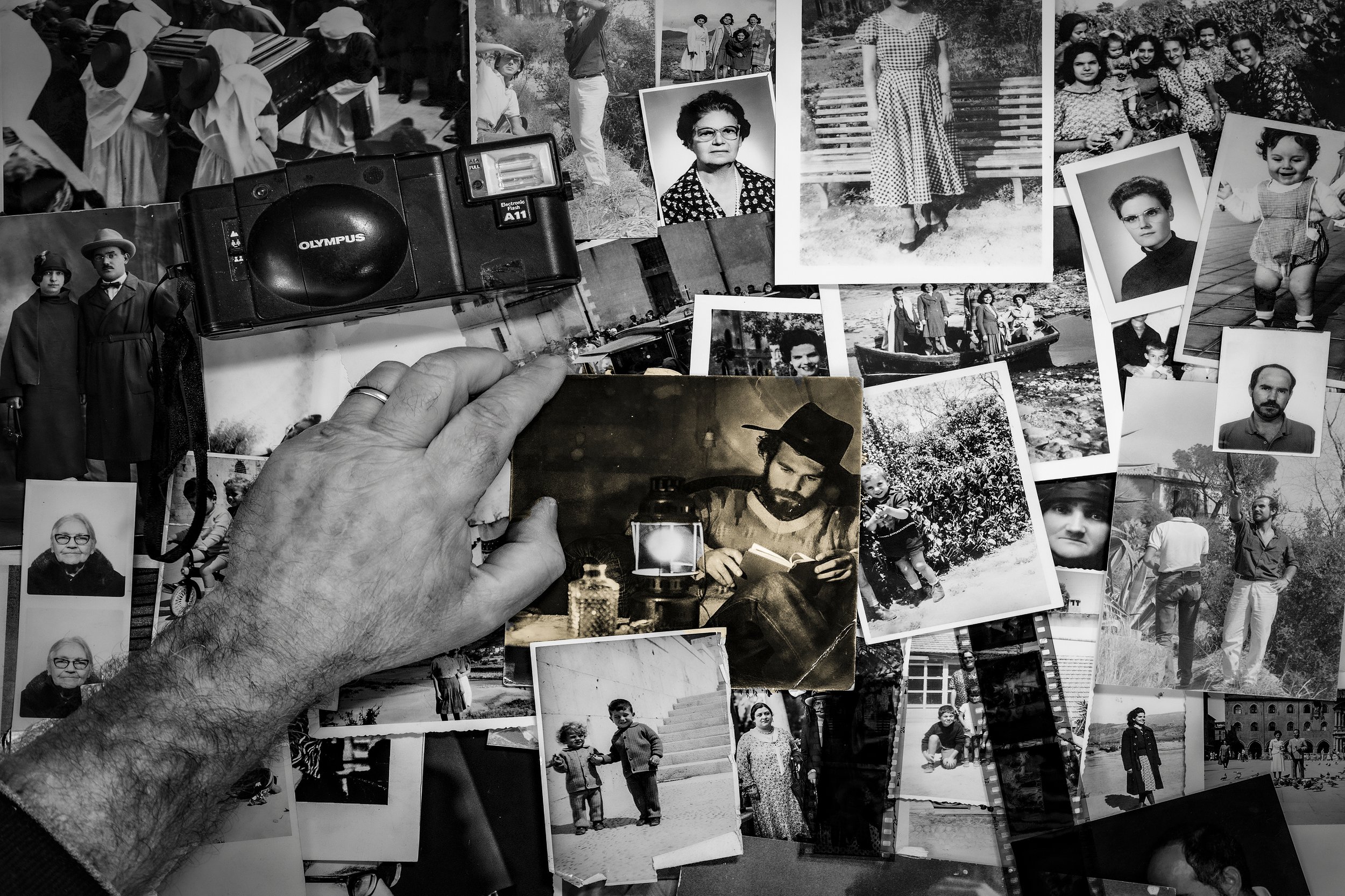
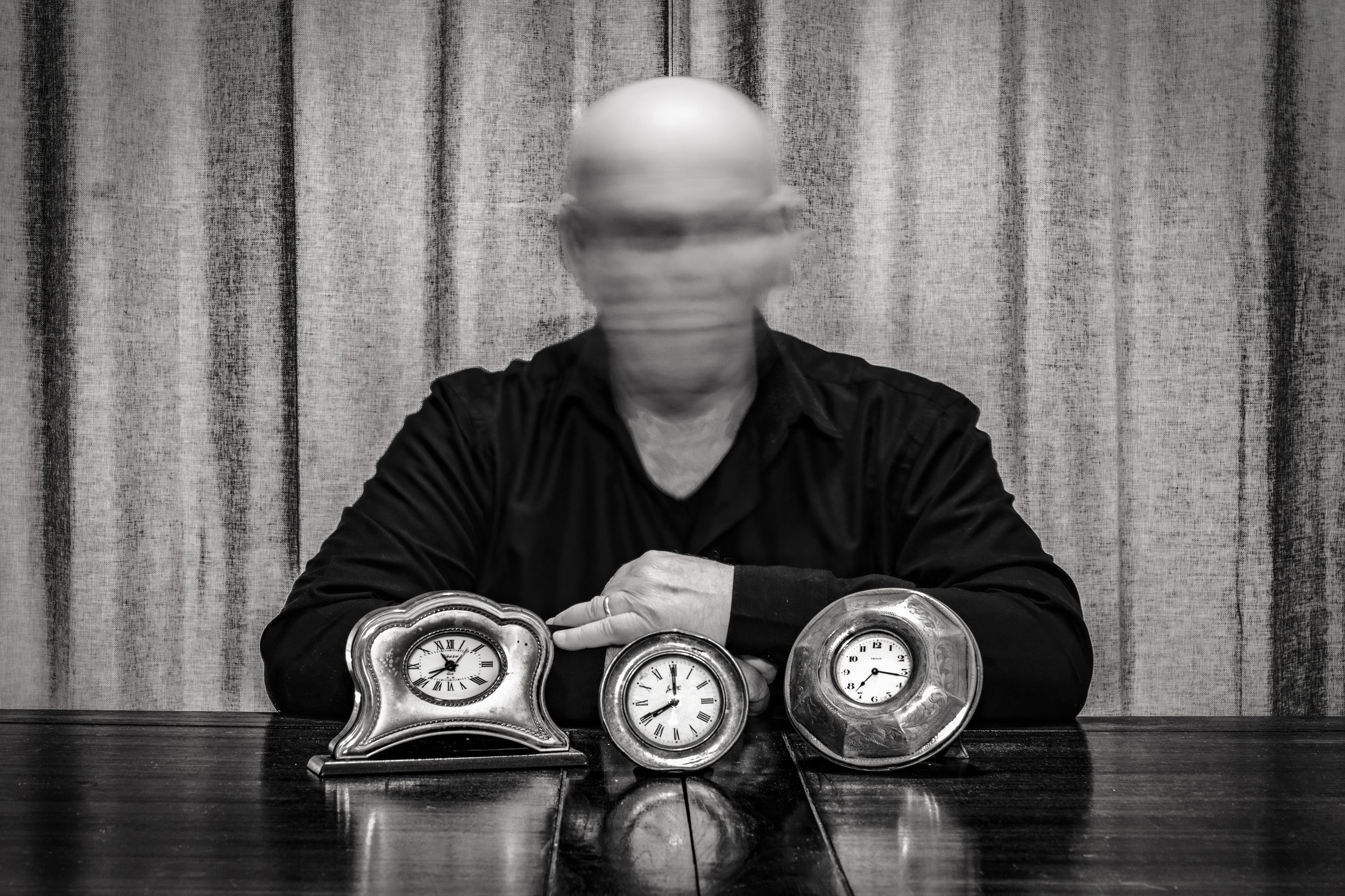
Petros Kotzabasis Petros Kotzabasis was born and bred in Komotini, a small town in northern Greece. His starting point is a quote by Odysseas Elytis, an eminent Greek poet, that goes as follows: “with lime twigs you may capture birds, yet you never capture their singing. It takes a different kind of twig….” He utilizes reality as a starting point for his photos, striving to express something that already existed within him, while also returning to life what he briefly borrowed but in an altered form as influenced by his own spirit. Therefore, his approach contrasts with that of photographers who engage in applied or commemorative photography, as they use photography to depict reality. In this series featuring Petros as the protagonist, the atmosphere is surreal and exudes a Beckettian spirit. However, it is the essence of the Balkans that permeates all of his images, including these self-portraits. “Alone” because he took these pictures of himself when he didn't have someone else with him to photograph.
Petros Kotzabasis- Another very strong set that has quite a surreal feel. The composition works really well in all five images without any obviously weak elements in any of the pictures. (John Gill)
The geometry elevates this photograph. (Michael Kennedy)
A beautiful b/w series, giving a sense of restlessness, journey impending. (Keef Charles)
Sylwia Ciszewska-Pęciak is a photographer and sociologist based in the UK. She finds inspiration for her street photography while living in West Bromwich, capturing unposed moments that reflect authentic human experiences. Following the birth of her daughter, she turned to documentary photography as a form of self-reflection and therapy. Her work also delves into various aspects of motherhood. She is part of the Women in Street collective and has exhibited her work in Poland and abroad.
"I am the mother. In this being, there is a thin line between the feeling of being complete and boundless love and renunciations and the compulsion to adapt. Sometimes I can't see myself anymore, my body is no longer mine. I feel transparent, blended into the background of everyday duties."
Sylwia Ciszewska Peciak - Wonderfully ambiguous. (Michael Kennedy)
This highly introspective series portrays skilfully how emotions can affect the frame of mind. (Keef Charles)
FOURTH PLACES
Lola Minister, Veronica Romanenghi, Li Biletska, Joshgun Suleymanov, Ana Maria Prelipcean, Iryna Vlasiuk
Lola Minister an artist who never wanted to show herself, is a creator who plays with the macabre, science fiction and literature, using photography as a brush to paint the surreality of her own world. Having grown up in the English countryside of Kent she left the chickens and family small holding behind for the glitz of the USA’s West Coast. After a few years living on that side of the Atlantic she heard the call of Europe once more and relocated to Paris, France and subsequently to the Côte d’Azur, where she creates the stuff of her imagination and dreams. I’m not the most comfortable person in front of the camera, even if the photographer is myself, so how should I go about this challenge? What could possibly represent me? Well, I love to visit art galleries, create surreal images and indulge in fantasy so these became the inspiration for my somewhat eclectic mini series, called The Artist Who Never Wanted to Show Herself.
Lola Minister - Straight out of the deep rabbit hole from Alice in Wonderland. So familiar yet so disconcerting. (Kevin Lim)
A creative and witty collection. (Keef Charles)
Veronica Romanenghi is a Photojournalist and Documentary Photographer based in Buenos Aires, Argentina. She attends several workshops with photographers as Alejandro Kuropatwa, Walter Astrada, Fernanda Iturrieta and Tony Valdez.
"Hanging by a thread." is a photographic essay based on the suffocation that the domestic world generates in women in general, and the world's attempt to domesticate them. She uses and place objects out of context in a domestic environment that generates strangeness and confusion.
Veronica Romanenghi – Veronica Romanenghi's work appears do draw inspiration from Cindy Sherman's style. The artist shares a commitment to self-portraiture, which is noteworthy. (Michael Kennedy)
Romanenghi demonstrates a remarkable ability to depict the various roles of women humorously.
Li Biletska is a photographer and visual artist from Kherson, Ukraine. She obtained her master's degree in Philology in 2018 and is currently pursuing her own path in photography. Her work addresses issues such as national identity, beauty, self-acceptance, and psychological challenges. “This project, ‘How Does It Feel?’, started accidentally from Bucha. It was a tsunami of horror, misunderstanding, rejection, pain, agony, hatred. These emotions burn me down. The only possible way to react to these atrocities while living in occupied Kherson was through art. This is how this series began. Unfortunately, the war gave many more reasons to create conceptual photos for this series. And, unfortunately, it will still give. "How Does It Feel?" is a classic question on psychotherapy. At the beginning of the war, I had a constant set of strong feelings: anger, rage, hatred, pain, sadness, longing, apathy. Now I noticed: with each flagrant crime of Russia, the meaning and significance of this list of feelings seem to be erased, leveled. For myself, I found a way to share my feelings when there are no words. This is the creation of a series with unique photo reflections on the painful events of the war. “
Li Biletska: "How does it feel?" – A strong expression of emotions and feelings. (Keef Charles)
Joshgun Suleymanov was born in 1987 in western Azerbaijan and has been practicing street photography for around ten years. He has authored exhibitions such as Retro Baku and Joshgun Street and is a member of the Azerbaijan Photographers Union. His work has been featured in publications in Argentina and Spain. Currently, he is working on new publications. This project combines street photography with the exploration of the inner self, potentially delving into the darker aspects of one's persona, as the title "The Darkness Inside Me" suggests.
Joshgun Suleymanov – Ephemeral, noir, subversive yet comforting. (Kevin Lim)
Self as a shadow. A strong, well-made and -chosen series. The only small quibble that I have is the inconsistency of the second photo being in colour while all the rest are monochrome. (Richard Bram)
Ana Maria Prelipcean, based in Bucharest, Romania, discovered film photography while studying journalism in the 90s. She prefers black and white photos with noise to capture the rawness of everyday life, emotions, and surrealism of the streets, using techniques like double exposures and slow shutter speeds to create otherworldly pictures. The collection called “Finding Myself” shows a strong similarity to the styles of well-known photographers Bill Brandt and Ralph Gibson, as mentioned by John Gill. The high contrast and grainy black and white look of the images is really striking. They give off a slightly claustrophobic feeling, while the single colour image seems to represent a longing for freedom or escape, even though it introduces uncertainty due to its thematic contrast with the others.
Ana Maria Prelipcean - A well-done series by the author. For future entries, the uniformity in the edition should be maintained. (Ana Abrão)
These pictures remind me of both Bill Brandt and Ralph Gibson, both photographers I admire. I like the high contrast, grainy look and if works perfectly with the black and white images in the set. I’m not sure on the colour picture, however. The mono images have a slightly claustrophobic atmosphere, and I think the colour image is there to represent striving for freedom or escape. I’m not sure if it might be too great a contrast to the other pictures to knit together thematically. (John Gill)
Iryna Vlasiuk, born in 1985 in Kyiv, Ukraine, has been a photographer for about 10 years, with a recent focus on art and nude photography. Her work explores aesthetics, human interaction, and the connection between the spiritual and physical. She was nominated in the Fine Art Photography Awards 6th for "Fashion" and has been featured in various galleries and publications. In 2021, she released a photography book called "Perception" and participated in a group exhibition in Kyiv, Ukraine. Additionally, she is a member of the Ukrainian Women Photographers Organization. Life Cycle is the title of her project. Kevin Lim correctly defines this series as mildly exhibitionistic yet at once familiar, surreal, and erotic.
Iryna Vlasiuk: Life Cycle – Love this series; mildly exhibitionistic yet at once familiar, surreal, and erotic. (Kevin Lim)
HONOURABLE MENTIONS
Polina Shumacher, Anton Zdanovich, Peter Hilden, Bogo Pečnikar, Ribhu Chaterjee, Lyn Hollenbeck, Eduardo Storch and Anton Konovalenko
Polina Shumacher, a Ukrainian photographer, is a member of MYPH School of Conceptual and Artistic Photography. The school was founded in 2018 by Serhiy Melnychenko in his hometown of Mykolaiv. The school's students are artists located both in the country and abroad. She lives in Lisbon. My project "The Dark Side Of The Moon" reflects my contemplations about the connection between reality and dreams, as well as between beauty and horrors. I describe memories from my childhood when the boundaries between different emotions and impressions were less noticeable.
Polina Shumacher – This series made me think about the eternal challenges of youth in a society that is destructive, in a world that cages you and abuses you. It is simple, sincere, and eloquent. (Batsceba Hardy)
Anton Zdanovich lives in Brest, Belarus. He describes himself as a photographer who captures the things he loves. His website features his works and all the necessary information. The project "Sick" is intriguing, as Richard Bram noticed. The five photographs are beautifully and artfully executed, constructing a solid psychological narrative that speaks to loneliness, depression, and perhaps even suicide. In these images, life becomes a game of chance or cards. Statistically, I get sick once a year, most often in the fall. For about a week, the world around me shrinks to the 70 square feet of my apartment. During these days, I don't go out for photo shoots, to the gym, or meet people. My leisure time is limited to the activities the apartment gives me. Throughout the week, I managed to run through all the stages of accepting the inevitable, stopping briefly at each one. Initially, it's always a little stressful, but as I adapt, I get used to my lot.
Anton Zdanovich: SICK – This is intriguing. Beautifully and artfully executed, the photographer has constructed a strong psychological narrative in these 5 photographs speaking to loneliness and depression, perhaps even to suicide. In these life becomes a roll of the dice or a game of cards. (Richard Bram)
Peter Hilden was born in 1956 in Germany and has worked as a medical doctor. He has been living in Hamburg for 20 years, residing on his ship on the river Elbe. Largely self-taught, he transitioned to digital photography in 2012, with a focus on urban spaces. He has participated in exhibitions under the pseudonym "minzpeter" and has won prizes in several competitions. Peter has been refining his photography style through seminars with Wolfgang Zurborn since early 2019. In terms of photography, I am primarily concerned with documentary urban photography. I look for chaos in the cityscape in order to structure it in complex compositions and make it legible. It is the fate of the photographer that he is the only one who is never captured in the scenery. Mirrors and other reflective surfaces make self-portraits possible - and so a large number of photos have been taken over the years without a concrete artistic concept. This has taught me a lot about my own style, because ideally my self-portraits always incorporate the urban space. In addition to the staging of the urban details, my appearance is the documentation of my existence. It is impressive how the street photographer has expressed his individuality in this project, “I exist”. There is a formal coherence in this series of self-portraits.
Peter Hilden – I appreciate how this street photographer has expressed his personality. I find a formal coherence in this series of self portraits. (Batsceba Hardy)
Bogo Pečnikar In 1957, he was born in the city of Ljubljana, which was a part of Yugoslavia before eventually becoming a part of Slovenia. Despite pursuing studies in architecture, his true passion lay in music, to which he dedicated most of his time and creativity. Approximately 40 years ago, he delved into photography as a means of documenting his family, but this interest gradually evolved into a deeply satisfying hobby. A few years ago, he rekindled his love for photography in the digital age, and it soon became almost an addiction for him. Presently, he identifies as an enthusiastic amateur photographer, always anticipating what the future holds. He is a master of capturing reflections through his lens. Every day, he ventures out on his walks, eagerly seeking out the interplay of light and colour and the captivating stories that unfold within each reflection. For this project, Self Reflection, he even turns the camera on himself, weaving his own story into the captivating tapestry of reflections.
Bogo Pečnikar – I know this photographer and I know that he is the photographer of reflections. He hunts for them during his daily walks, capturing the interplay of light, colors, and stories, and this time, even himself. (Batsceba Hardy)
Ribhu Chatterjee is a visual artist and video journalist at The Quint. He hails from Kalyani, West Bengal. Recently, he has been immersing himself in the world of photojournalism and documentary photography. Armed with his trusty Nikon camera equipped with 18-55mm and 70-300mm lenses, he tirelessly captures the essence of various narratives. In moments when his Nikon is not within reach, he deftly wields his Samsung A52 to continue his creative pursuit. One of his compelling recent endeavours, "The New Normal," delves into the profound impact of the pandemic on people's everyday lives and behaviours. “Seeking myself”
Ribhu Chaterjee: Seeking myself is the name we chose for this distinctly conceptual project.: the photographer experiments with the photographic medium, using himself as the subject, in a rediscovery of his essence. (Batsceba Hardy)
Lyn Hollenbeck was born in 1952 in Coffeyville, Kansas, a small town in the United States. His photographic experience began about 15 years ago and while developing a point of view of the world through the lens of a camera he discovered a beauty and art in the world around him. Therefore everything that finds itself in front of my lens gets photographed. I have titled this this series of photographs, Self: a display in fragments. They portray a complex of conscious and unconscious ideas about myself, complexities inherent in every individual of which I present myself here as a representative
Lyn Hollenbeck –another photographer who, playing with his camera, searches for himself, expressing a palpable loneliness. (Batsceba Hardy)
Eduardo Storch a retired OBGYN, was born in Montevideo. His last name, which means stork in German, seems to align with his passion for "street photography". About 15 years ago, he was invited to a photography course by friends and has since pursued photography more intensively after retiring. My project, "The Mirror of My Mirrorless Camera", reflects my self-contemplation in various everyday situations. The viewer can understand the photographer through what he is looking at. In my self-portraits, I try to show them how I see myself.
Eduardo Storch - A beautiful series of self-portraits, which go beyond the "street". As if the photographer wanted to place a signature. (Batsceba Hardy)
In conclusion, we have this shocking series by Anton Konovalenko –”Phanton Teneta"–, which is difficult to rate without a presentation of its concept.
“This series serves as a metaphorical self-exploration of the impact of war. Each photograph reflects the inner world, with my multi-tentacled creature becoming a mystical symbol of my emotional state. The tentacles tell stories in the labyrinth of life’s trials.
Imagine what a sentient creature feels when caught in traps that are likely a threat to it, when its voice is unheard and when those who hunt do not comprehend the tragedy of the circumstances. The octopus, as a symbol of high intelligence, seeks to evade danger, swimming in the chaos of dark waters. The worms, as symbols of change and transformation, embody the primal fear of turbulent changes and the expectation of rebirth. The blurriness of the images underscores the instability and uncertainty of life, giving the frame a mystical and gloomy hue”. (Anton Konovalenko)
Anton Konovalenko from Kyiv, Ukraine, is also a member of MYPH School of Conceptual and Artistic Photography.
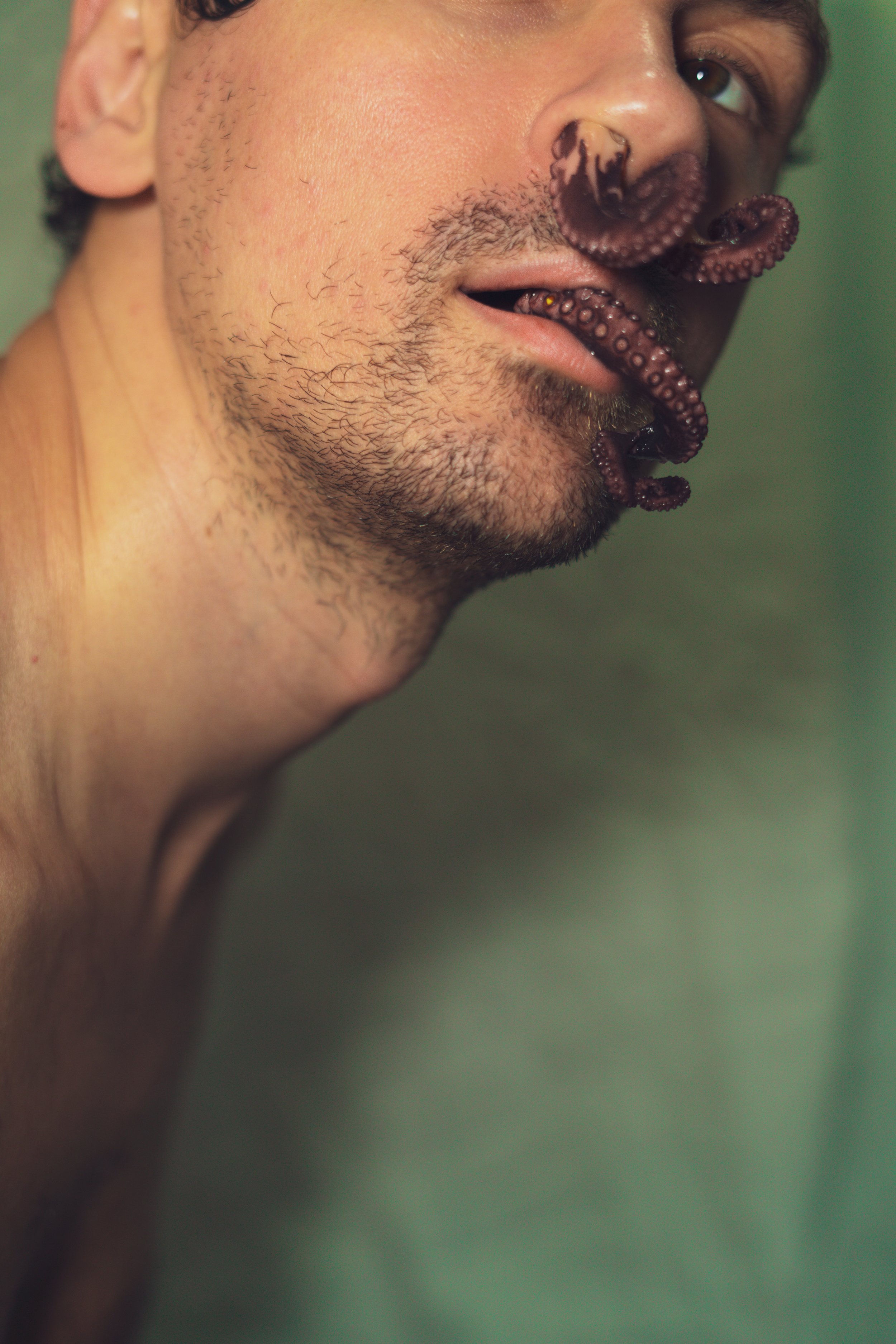
Anton Konovalenko

